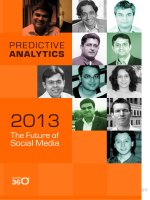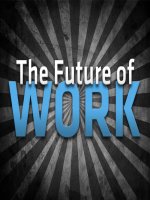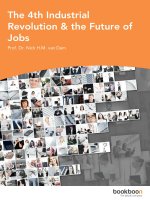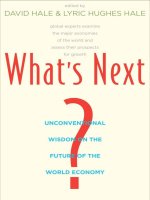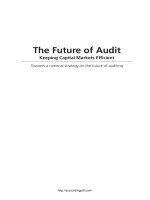The 4th industrial revolution the future of jobs
Bạn đang xem bản rút gọn của tài liệu. Xem và tải ngay bản đầy đủ của tài liệu tại đây (1.18 MB, 37 trang )
PROF. DR. NICK H.M. VAN DAM
THE 4TH INDUSTRIAL
REVOLUTION & THE
FUTURE OF JOBS
Download free eBooks at bookboon.com
2
The 4th Industrial Revolution & The Future of Jobs
1st edition
© 2017 Prof. Dr. Nick H.M. van Dam & bookboon.com
ISBN 978-87-403-1883-8
All rights reserved. No part of this book may be reproduced, stored, or transmitted by any
means—whether auditory, graphic, mechanical, or electronic—without written permission of
both publisher and author, except in the case of brief excerpts used in articles and reviews
and/or the re-usage of illustrations as long as the source is cited.
The book doesn’t include citations but all sources used are included in the reference
section of the book.
Neither the publisher nor author assume any liability for any errors or omission or for how
this book or its content are used or interpreted or for any consequences resulting directly
or indirectly from the use of this book.
The author will donate all royalties to the e-Learning for Kids Foundation.
This organization provides free digital learning for underserved elementary school children:
Website: www.e-learningforkids.org
Download free eBooks at bookboon.com
3
THE 4TH INDUSTRIAL REVOLUTION
& THE FUTURE OF JOBS
BOOKS FROM THE AUTHOR
26
CONTENTS
About the author
5
1
Disruption Ahead
7
2
The Future of Jobs
16
3
Change In Skills
22
4
New Jobs
25
Books from the Author
26
The e-Learning for Kids Foundation
28
References
30
Download free eBooks at bookboon.com
4
ABOUT THE AUTHOR
PROF. DR. NICK VAN DAM is full professor CORPORATE
LEARNING & LEADERSHIP DEVELOPMENT.
Nick has a passion for people development and is excited
about helping individuals to reach their full potential. He
strongly believes that lifelong learners are more successful
professionally and lead happier, more fulilling lives. Nick is
keenly interested in the emerging insights from the ields of
positive development including: Psychology, Sociology, Cognitive Neuroscience, Andragogy
and Philosophy. hese all have enormous potential to transform people development and to
lead to the creation of healthy, humanly sustainable organizations. Nick studied Economics,
Business Economics and Pedagogy (Vrije Leergangen – Vrije Universiteit van Amsterdam),
Organizational Sociology (Universiteit van Amsterdam) and earned his Doctorate of Philosophy
(Ph.D., Human Capital Development).
He started his career in 1986 as a training consultant at (Siemens-) Nixdorf. In 1995, he
joined Deloitte Consulting in the USA and served for 19 years in international Consulting/
Learning & Development/Human Resources executive roles. Currently he is a partner,
Global Chief Learning Oicer and Client Advisor at McKinsey & Company. Nick is a
visiting professor and advisory board member at the University of Pennsylvania’s, PennCLO
Executive Doctorate Program. In 2016, he joined the Corporate Advisory Board of edX
which is a non-proit organization founded by Harvard and MIT, with a mission to bridge
the gap between education and employment.
Nick has (co)authored 17 books and is an internationally known thought leader in Human
Capital Development. His latest book: YOU! he Positive Force in Change. Nick has
written many articles and has been quoted by he Financial Times, he Wall Street Journal,
Fortune Magazine, Business Week, Harvard Business Review, he India Times, Information
Week, Management Consulting, CLO Magazine, and T+D Magazine. Under the patrons
of the European Parliament Federal Ministry of Education & Research, he received ‘he
2013 Leonardo European Corporate Learning Award’ for shaping the future of organizational
learning and leadership development.
Download free eBooks at bookboon.com
He is the Founder and Chairman of e-Learning for Kids (www.e-learningforkids.org), a
global non-proit foundation that ofers free, digital lessons for underserved elementary
school aged children worldwide.
Dr. Nick van Dam and Dr. Jacqui Brassey have developed diagnostic instruments to help
you grow and develop:
A. MINDSETS FOR LIFELONG LEARNERS and
B. AUTHENTIC PROFESSIONAL CONFIDENCE.
Take our free assessments at: www.reachingyourpotential.org
Download free eBooks at bookboon.com
THE 4TH INDUSTRIAL REVOLUTION
& THE FUTURE OF JOBS
1
DISRUPTION AHEAD
DISRUPTION AHEAD
I am proud to be the second generation of my family who has worked in the township
‘Breukelen – Nijenrode’. My great-great-great grandfather Matijs van Dam (1763–1823)
who lived about 200 years ago, was a so called day labourer (in Dutch dagloner) and was
paid for each day that he worked in agriculture. In the Netherlands today, we would have
called him a zzp-er or in English a contractor or free agent. Matijs grew up in a largely
agricultural society. Around 1810 in the Netherlands, an estimated 45% of a population
of 2 million people worked in agriculture. he Netherlands had been one of the wealthiest
modern economies of the world, but due to a crippling public debt and geo-political factors
it lost this position between 1800–1850.
FIGURE 3: NYENRODE AT THE TIME OF MATIJS VAN DAM (1763–1824)
Source: Jacobus Schijnvoet
Matijs lived during a time of signiicant change. He was the witness of six tumultuous
historical stages of governance, including:
•
•
•
•
•
•
De Republiek van de Zeven Verenigde Nederlanden (1588–1795);
De Bataafse Republiek (1795–1801)
Het Bataafs Gemenebest (1801–1806)
Het Koninkrijk Holland (1806–1810)
Het Eerste Franse Keizerrijk (1810–1813)
Het Koninkrijk der Nederlanden (1813/1815–today)
Download free eBooks at bookboon.com
7
THE 4TH INDUSTRIAL REVOLUTION
& THE FUTURE OF JOBS
DISRUPTION AHEAD
Relatively shortly after the establishment of the Kingdom of the Netherlands, Matijs also
experienced a development that we would have called Bexit, when in 1830 Belgium separated
from the Kingdom of the Netherlands.
FIGURE 4: THE FIRST INDUSTRIAL REVOLUTION: MECHANIZATION & STEAM POWER
Matijs lived at the beginning of the First Industrial Revolution in Britain (est. 1760–1840),
which spread internationally.
his period was driven by technology inventions, particularly the steam engine, which
improved the way that machines could be operated. A strategic application of the steam
engine was the steam locomotive which was invented in 1804. he irst railway line opened
in the Netherlands in 1839 and the expansion of the railway net was another motor behind
industrialization. he mechanization of agriculture resulted in a growth of a number of
new factories for example: sugar factories, potato factories, lour factories, and strawboard
factories. Agriculture continued to be the biggest economic sector in the Netherlands during
the 19th century. However the industrialization also fueled the rise of other industries such
as the textile industry, machine industry, leather-shoe industry, and the cigar industry, to
name a few. And these developments demanded new skill sets from the labourers.
A consequence of the First Industrial Revolution in the Netherlands was that handmade
crafts businesses could not compete with the products from the factories and closed down.
Former craft workers (including women and children) tried to ind jobs at factories. hus,
the supply of labour exceeded the demand which resulted in very low wages for long hours
of work. And this produced a growing gap between the rich and the poor.
Download free eBooks at bookboon.com
8
THE 4TH INDUSTRIAL REVOLUTION
& THE FUTURE OF JOBS
DISRUPTION AHEAD
FIGURE 5: THE SECOND INDUSTRIAL REVOLUTION:
MASS PRODUCTION & ASSEMBLY LINE
Source: Movie Modern Times, Charlie Chapin, 1936.
he Second Industrial Revolution (1870–1914), also known as the Technological Revolution
started in the inal third of the 19th century, when new technologies brought mass production
and rapid industrialization accompanied by the introduction of assembly lines and electriication.
Many more factories were built during the Second Industrial Revolution and new jobs
were created for people to work on machines. However, existing work was replaced as well.
For example, agriculture machines increasingly replaced the work formerly done by people
and animals.
Workers in factories experienced a challenging life. hey typically worked 10 hours a day,
6 days a week, and the working conditions were often unsafe and most work was drudgery.
In the famous movie Modern Times (1936), Charlie Chaplin portrays the manic pace of the
factory worker on an assembly line. he ilm well depicts the employment conditions that
were created by the Second Industrial Revolution.
FIGURE 6: THE THIRD INDUSTRIAL REVOLUTION: COMPUTER & AUTOMATION
Source: picture Steve Jobs and Steve Wozniak
Download free eBooks at bookboon.com
9
THE 4TH INDUSTRIAL REVOLUTION
& THE FUTURE OF JOBS
DISRUPTION AHEAD
he hird Industrial Revolution (1960–1990) brought mainframe computers (1960),
personal computing (1970s and 1980s), and the Internet (1990s). his revolution altered the
interaction between individuals and companies. Technological advancement placed pressure
on the traditional middle class who worked in transaction jobs. For example, the following
jobs declined between 1970–2010 because of automation: general clerks (-37%); bookkeeping
jobs (-43%); secretaries (-59%); typists (-80%); and telephone operators (-86%).2 On the
other hand, a lot of non-transactional and non-production jobs were created that required
complex problem solving skills, signiicant experience, and speciic contextual knowledge,
e.g. software developers, computer designers, pc network specialists, printer technicians,
and IT consultants.
FIGURE 7: THE FOURTH INDUSTRIAL REVOLUTION: CYBER PHYSICAL SYSTEMS
Source: www.jllrealviews.com.
Today, we are at the beginning of the Fourth Industrial Revolution (2012– ), which can be
described as the advent of “cyber-physical systems” involving entirely new capabilities for
people and machines. A cyber-physical system can be deined as a mechanism controlled
or monitored by computer-based algorithms, tightly integrated with internet and its users.
his revolution is fueled by smaller and more powerful sensors, the mobile internet, machine
learning, and artiicial intelligence.
he Fourth Industrial Revolution was the theme of the 2016 World Economic Forum
(WEF) in Davos. Professor Klaus Schwab, the founder and executive chairman of the WEF,
has published a book on this topic.
Some people refer to this revolution as a combination of Industry 4.0 and Smart Services.
Others combine the trends of the hird and Fourth Industrial Revolution and continue to
call it the hird Industrial Revolution or the Digital Revolution.
Download free eBooks at bookboon.com
10
THE 4TH INDUSTRIAL REVOLUTION
& THE FUTURE OF JOBS
DISRUPTION AHEAD
Schwab (2016) identiied three reasons how the Fourth Industrial Revolution is diferent
from the hird Industrial Revolution:
• Velocity – his revolution is exponential rather than linear.
• Breadth and depth – It builds on the hird Industrial Revolution and combines
multiple technologies that are leading to unprecedented paradigm shifts in the
economy, business and society.
• System impact – It involves the transformation of entire systems, across and within
countries, companies, industries and society as a whole.
he Fourth Industrial Revolution is driven by advancements in technologies that have
a signiicant potential to cause disruption. Over history we have seen that technological
breakthroughs are speeding up.
FIGURE 8: THE BREAKTHROUGH OF TECHNOLOGIES IS SPEEDING UP
Source: McKinsey Global Institute analysis, 2016.
he adoption of new technologies is also accelerating. For example, the time it took for
an invention to reach 50 million users globally was for radio 38 years, TV (13 years), iPod
(4 years), Internet (3 years), Facebook (1 year), Twitter (9 months), Angry Birds (35 days)
and Pokémon GO (19 days).3
McKinsey Global Institute (2013) researched and identiied twelve potential economically
disruptive technologies.
Download free eBooks at bookboon.com
11
THE 4TH INDUSTRIAL REVOLUTION
& THE FUTURE OF JOBS
DISRUPTION AHEAD
ILLUSTRATED GROUPS, PRODUCTS AND
TECHNOLOGY
RESOURCES THAT COULD BE IMPACTED
Mobile Internet
Increasingly inexpensive and capable mobile
computing devices with Internet connectivity
4.3 billion People remaining to be connected
to the Internet, potentially through the
mobile Internet.
1 billion Transaction and interaction workers,
nearly 40% of the workforce
Automation of Knowledge Work Intelligent
software systems that can perform knowledge
work tasks involving unstructured commands
and subtle judgments
230+ million Knowledge workers, 9% of
global workforce
1.1 billion Smartphone users, with
the potential to use automated digital
assistance apps
The Internet of Things
Networks of low cost-sensors and actuators
for data collection, monitoring, decision
making, and process optimization
1 trillion Things that could be connected
to the Internet across industries such as
manufacturing, health care, and mining
100 million Global machine to machine
device connections across sectors such as
transportation, security, health care, and utilities
Cloud Technology
Use of computer hardware and software
resources delivered over a network or the
Internet, often as a service
2 billion Global users of cloud-based email
services like Gmail, Yahoo, and Hotmail
80% North American institutions hosting or
planning to host critical applications on the cloud
Advanced Robotics
Increasingly capable robots with enhanced
senses, dexterity, and intelligence used to
automate tasks or augmented humans
320 million Manufacturing workers, 12% of
global workforce
250 million Annual major surgeries
Autonomous and Near-autonomous Vehicles
Vehicles that can navigate and operate with
reduced or no human intervention
1 billion Cars and trucks globally
450.000 Civilian, military, and general
aviation aircraft in the world
Next-generation of Genomics
Fast, low cost gene sequencing, advancing
big data analytics, and synthetic biology
26 million Annual deaths from cancer,
cardiovascular disease, or type 2 diabetes.
2.5 billion People employed in agriculture
Energy Storage
Devices or systems that store energy for later
use, including batteries
1 billion Cars and trucks globally
1.2 billion People without access to electricity
3D Printing
Additive manufacturing techniques to create
objects by printing layers of material based
on digital models
320 million Manufacturing workers, 12% of
the global workforce.
8 billion Annual number of toys manufactured
globally
Download free eBooks at bookboon.com
12
THE 4TH INDUSTRIAL REVOLUTION
& THE FUTURE OF JOBS
DISRUPTION AHEAD
ILLUSTRATED GROUPS, PRODUCTS AND
TECHNOLOGY
RESOURCES THAT COULD BE IMPACTED
Advanced Materials
Materials designed to have superior
characteristics (e.g., strength, weight,
conductivity) or functionality
7.6 million tons Annual silicon consumption
45,0000 metric tons Annual global carbon
fibre consumption
Advanced Oil and Gas Exploration
and Recovery
Exploration and recovery techniques that
make extraction of unconventional oil and
gas economical
22 billion Barrels of oil equivalent in natural
gas produced globally.
30 billion Barrels of crude oil produced globally
Renewable Energy
Generation of electricity from renewable
sources with reduced harmful climate impact
21,000 TWh Annual global electricity
consumption
13 billion tons Annual CO2 emissions from
electricity generation, more than from all cars,
trucks and planes
In 2016, he World Economic Forum published the top technological drivers of change
including the expected timeframe of impact.4
he list overlaps signiicantly with the technologies mentioned before and includes:
1. Mobile Internet and cloud technology (2015–2017)
2. Advances in computer power and big data (2015–2017)
3. New energy supplies and technologies (2015–2017)
4. he Internet of hings (2015–2017)
5. Crowdsourcing, the sharing economy and peer-to-peer platforms (impact felt already)
6. Advanced robotics and autonomous transport (2018–2020)
7. Artiicial intelligence and machine learning (2018–2020)
8. Advanced manufacturing and 3D printing (2015–2017)
Advanced materials, biotechnology and genomics (2018–2020) It is important to understand
the timing at what time technology applications will have a major impact. hese tipping
points are “moments when speciic technology hits mainstream society shaping the future digital
and hyper-connected world.” 5
he list of expected tipping points in application of diferent technologies that are expected
to occur by 2025 include, for example (WEF, 2015):
Download free eBooks at bookboon.com
13
THE 4TH INDUSTRIAL REVOLUTION
& THE FUTURE OF JOBS
DISRUPTION AHEAD
LIKELIHOOD THAT THIS
PREDICTION
WILL HAPPEN AS A %
10% of people wearing clothes connected to the Internet
91.2%
90% of people having unlimited and free storage of data
91.0%
1 trillion sensors connected to the Internet
89.2%
The first robotic pharmacist in the USA
86.5%
10% of reading glasses connected to the Internet
85.5%
5% of consumer goods printed in 3D
81.1%
90% of the population using smartphones
90.7%
Driverless cars equalling 10% of cars on US roads
78.2%
New technologies can have an impact on economic growth, as well as having the capacity
to disrupt. he early 20th century economist Joseph Schumpter (1883–1950) studied the
formation and bankruptcy of companies in Europe and the United States. He concluded
that signiicant advances in industries are accompanied by a process of creative destruction,
which shifts proit pools, rearranges industry structures, and replaces incumbent businesses.6
Schumpeter believed that “economic progress, in capitalist society, means turmoil.” Professor Richard
Foster, a professor at Yale and a former McKinsey consultant, applied Schumpeter’s theory
to modern practices of management and innovation in his book Creative Destruction (2001).
Foster studied the lifespan of the most prestigious companies listed on the Standard &
Poor top 500 list.
1.0
90
90
0.9
80
0.8
70
0.7
60
0.6
50
45
0.5
40
0.4
30
0.3
30
20
0.2
13
10
0.1
0
20
1935
1955
1975
Est. 2015
Est. 2027
FIGURE 9: COMPANIES’ LIFESPAN HAS DECLINED DRAMATICALLY OVER TIME
Source: Foster, 2012
Download free eBooks at bookboon.com
14
THE 4TH INDUSTRIAL REVOLUTION
& THE FUTURE OF JOBS
DISRUPTION AHEAD
He noticed that the lifespan of companies has dramatically declined from 90 years in 1935
to 18 years in 2011. He predicts that the lifespan of an S&P 500 company in 2027 will be
13 years or less. his doesn’t mean necessarily that all companies will land in the graveyard in
13 years, but that they might split, merge or be acquired and disappear from the S&P 500.
According to Foster, (2001) the lifespan of a corporation is determined by balancing three
management imperatives: 1) running operations efectively; 2) creating new businesses which
meet customer needs; and 3) shedding business that once might have been core but no
longer meets company standards for growth and return.
he challenge is the dilemma that corporations need to innovate in order to create new
businesses, but that investment in innovation often conlicts with (short-term) operational
efectiveness. he outcome is that large corporations are not aligning themselves fast enough
with a changing external environment and slowly fall behind and disappear.
he implication for employees is that that concept of lifetime employment or just working for
a few companies doesn’t exist anymore. Furthermore, the Fourth Industrial Revolution will
dramatically change the skills required of the workforce. People need to prepare themselves
to work for a number of companies during their careers, and need to make sure that they
acquire skillsets and experiences that are valuable in the market.
he greatest diference between the Fourth Industrial Revolution and the prior hird
Industrial Revolution is the ubiquitous involvement of everyone and everything, and the
velocity of change.
Download free eBooks at bookboon.com
15
THE 4TH INDUSTRIAL REVOLUTION
& THE FUTURE OF JOBS
2
THE FUTURE OF JOBS
THE FUTURE OF JOBS
The best way to predict the future is to invent it.
– Alan Kay
“There’s never been a better time to be a worker with special skills or the right
education, because these people can use technology to create and capture
value. However, there’s never been a worse time to be a worker with only
‘ordinary’ skills and abilities to offer, because computers, robots and other digital
technologies are acquiring these skills and abilities at an extraordinary rate.” 7
– Erik Brynjolfsson and Andrew McAfee, MIT Initiative on the Digital Economy
Many of the new technologies are disrupting labour markets. Advancements in technologies
and new business models are expected to have a profound impact on existing and future jobs,
from job creation to job displacement. his has also happened during the First, Second, and
hird Industrial Revolution where jobs were eliminated in one sector (such as agriculture)
and new work was created in other sectors such as manufacturing and services.
100
80
Construction
Manufacturing
Agriculture and fishing
Services
60
40
20
0
1841 51 61 71 81 91 01 11 21 31 41 51 61 71 81 91 01 2011
FIGURE 10: JOBS COME AND GO: SHARE OF EMPLOYMENT IN BRITAIN BY INDUSTRY, %
Source: ONS & economist.com, 2016
Download free eBooks at bookboon.com
16
THE 4TH INDUSTRIAL REVOLUTION
& THE FUTURE OF JOBS
THE FUTURE OF JOBS
Internationally, jobs are not only threatened by technologies such as robotics, but also by
declining demand in many industries along with outsourcing (domestic or international).
For example, in 2015 about 2.3 million jobs in the US were outsourced internationally.8
Some researchers claim that outsourcing can help retain jobs or even create new ones in
the country of origin for example jobs with a higher level of complexity.9
During the Great Recession (2008–2010) 8,792.000 jobs were lost in the private sector in
the US and 8,709.000 new jobs have been gained between 2010 and 2014. However, the
middle-and higher income jobs were replaced by low-income jobs.
Jobs lost: 2008–2010
Higher-wage industries
($20.03–$32.62)
Mid-wage industries
($13.73–$20.00)
Lower-wage industries
($9.48–$13.33)
Jobs gained: 2010–2014
-3,579
2,603
-3,240
2,282
-1,973
-4,000 -3,000 -2,000 -1,000
3,824
0
1000
2000
3000
4000
FIGURE 11: NET CHANGE IN PRIVATE-SECTOR EMPLOYMENT (IN THOUSANDS)
Source: Nelp.org, 2015.
Historically, diferent economists have been concerned about the impact of technology on
the workforce. he economist David Ricardo (1772–1823) commented that the deployment
of machinery would have a devastating impact particularly on the labouring class.
John Maynard Keynes (1883–1946) predicted widespread technology-driven unemployment
“due to our discovery of means of economising the use of labour outrunning the pace at which
we can ind new uses for labour.”10
he new generation of technologies which are being deployed in the Fourth Industrial
Revolution will have the potential to threaten jobs which previously were not impacted by
technologies. A study from Oxford University (2013) predicts that 47% of all jobs in the
United States have a 70% probability of disappearing over the next 2 decades.
Download free eBooks at bookboon.com
17
THE 4TH INDUSTRIAL REVOLUTION
& THE FUTURE OF JOBS
THE FUTURE OF JOBS
99.0
Telemarketers
Accountants and auditors
94.0
Retail Salespeople
92.0
89.0
Technical writers
86.0
Real estate sales agents
81.0
Word processors and typists
65.0
Machinists
43.0
Economists
0.4
Dentists
FIGURE 12: HOW VULNERABLE ARE JOBS TO COMPUTERIZATION
Source: Frey & Osborne, 2013.
Other studies (Bowles, 2014) inds the share of jobs that are vulnerable to automation in
Europe ranges between 45% to more than 60%, with the Southern European workforce
facing the highest exposure to potential automation. Employers in the Netherlands expect that
22% of existing jobs will be automated over the next three decades (ING, 2016). However,
Dutch employees are more sombre and anticipate that 37% of jobs will be displaced by
2046. An OECD report11 is more optimistic and predicts that just 10% of the work in the
Netherlands has a high risk of being automated. he OECD researchers claim that the threat
from technological advances seems less because they take into account the heterogeneity
of workers’ tasks within occupations, compared to using the occupation-based approach.
A 2015 McKinsey Global Institute study12 also looked at job activities versus occupations.
hey concluded that current demonstrated technologies could automate 45% of the activities
people are paid to perform and that about 60% of all occupations could see 30% or more
of their activities automated. he OECD signals a very high chance of automatability of
jobs now held by less skilled people and people with lower incomes.
Download free eBooks at bookboon.com
18
THE 4TH INDUSTRIAL REVOLUTION
& THE FUTURE OF JOBS
THE FUTURE OF JOBS
100
80
60
40
20
0
Primary
Lower
Upper
Post
Short cycle Bechelor Master/PhD
or less secondary secondary secondary tertiary
FIGURE 13: SHARE OF WORKERS AT HIGH RISK OF AUTOMATABILITY BY LEVEL OF EDUCATION
Source: OECD, 2016
he World Economic Forum conducted research (2015) of the shorter- term impact of
automation and digitization on global employment. heir research among 15 major developed
and emerging economies (excluding China) suggests that the global net employment outlook
2015–2020 will be negatively impacted by more than 5.1 million jobs.
Net employment will decrease by 7.1 million jobs in a number of job families while the
WEF expect an increase of 2 million jobs among other job families.
Download free eBooks at bookboon.com
19
THE 4TH INDUSTRIAL REVOLUTION
& THE FUTURE OF JOBS
THE FUTURE OF JOBS
NET EMPLOYMENT OUTLOOK BY JOB FAMILY, 2015–2020
(15 COUNTRIES, EXCEPT CHINA)
Employees (thousands, all focus countries)
-4,759
Office and
Administrative
+492
Business and
Financial Operations
-1,609
Manufacturing and
Production
+416
Management
-497
Construction and
Extraction
+405
Computer and
Mathematical
-151
Arts, Design, Enterainment,
sports and Media
+339
Architecture and
Engineering
-109
Legal
+303
Sales and Related
Installation and
Maintenance
-40
Education and
Training
+66
Source: WEF, 2016
he McKinsey Global Institute (2016) conducted a detailed analysis13 of 2,000 plus work
activities for more than 800 occupations in the US. hey examined the technical feasibility
of occupational activities being automated using currently demonstrated technologies.
Managing
others
Appling
expertise
Stakeholder
interactions
Unpredictable
physical work
Data
collection
Data
processing
Predictable
physical work
12
17
16
18
Time spent in all US occupations, %
7
14
16
FIGURE 14: TYPES OF ACTIVITIES THAT HAVE THE TECHNICAL POTENTIAL TO BE AUTOMATED
Source: McKinsey Global Institute, 2016
Download free eBooks at bookboon.com
20
THE 4TH INDUSTRIAL REVOLUTION
& THE FUTURE OF JOBS
THE FUTURE OF JOBS
Occupations are made up of diferent types of activities which vary in their potential
of becoming automated. Also, the total time that people spend on activities in diferent
occupations varies. About one-ifth (18%) of the time spent in the US workplace includes
predictable physical activities, which are highly vulnerable for automation. here are also
signiicant diferences by sector, e.g. performing physical activities represents one third of
people’s time in manufacturing. About 73% of activities workers perform in food services
and accommodation industry have the potential for automation. hink about machines that
can bake hamburgers, self-service ordering and robotic servers. In inance and insurance –
about 50% of time is devoted to collection and processing data where the potential for
automation is high. It is anticipated that there will be signiicant changes in employment by
industry and industry sub-sector. Citigroup (2016), an American multinational investment
bank, is forecasting that US and European Banks will cut staf by more than 30% over the
next decade. Healthcare’s potential for automation is about 36%, but this is much lower
for the professionals whose daily activities require expertise and direct contact with patients.
In conclusion – the research reports indicate that the advancement of technologies will have
an impact on the displacement of jobs. However, they difer in percentage of replacement
(e.g. from 10% to about 49%), changes by economies (e.g. the Netherlands versus Japan),
the pace of impact (short-term versus medium-, or longer-term) and entire jobs versus
speciic activities by job.
here are many factors which predict whether jobs can be automated including: the
technical feasibility; the costs of developing and utilizing the hardware and software for
automation; the costs of labour and related supply-and-demand dynamics; the beneits of
automation beyond labour substitution including higher levels of output, better quality,
fewer errors; and regulatory and social acceptance issues. However, it is expected that if
current technology continues in its exponential development, there will be an increase in
the potential of automation.
Download free eBooks at bookboon.com
21
THE 4TH INDUSTRIAL REVOLUTION
& THE FUTURE OF JOBS
3
CHANGE IN SKILLS
CHANGE IN SKILLS
Most of the technologies discussed in the prior sections, have already had a signiicant
impact on employee skills. his is particularly true in the case of the mobile internet, cloud
technology, processing power, big data, new energy supplies and technologies, the sharing
economy, and crowdsourcing. Other technologies are expected to have a more profound
impact between 2018–2025 including: the Internet of hings; robotics; autonomous
transport; artiicial intelligence; advanced manufacturing; 3D printing; advanced materials
and biotechnology.
he acceleration of technology will shorten the shelf life of existing knowledge, expertise
and skills, and require diferent competencies which need to be developed. For example,
as speciic activities of jobs become automated, people will be required to focus on new
activities which require diferent skills. Technological skills will experience the fastest change.
An estimate of 50% of subject knowledge obtained during the irst year of a four year
technical degree program is outdated by the time of graduation15. Beyond technical skills or
hard skills, employers are equally concerned about work-related practical skills like content
creation or judging the relevance and purpose of information, which are also likely to be
subject to signiicant change in the coming years.
THE IMPORTANCE OF WORK-RELATED SKILLS
GROWING SKILLS
% OF JOBS WHICH REQUIRE
DEMAND IN 2020
THIS SKILL BY 2020
Cognitive Abilities
52%
15%
System Skills
42%
17%
Complex Problem Solving
40%
36%
Content Skills
40%
10%
Process Skills
39%
18%
Social Skills
37%
19%
Resource Management Skills
36%
13%
Technical Skills
33%
12%
Physical Abilities
31%
4%
SKILLS FAMILY
Download free eBooks at bookboon.com
22
THE 4TH INDUSTRIAL REVOLUTION
& THE FUTURE OF JOBS
CHANGE IN SKILLS
Source: WEF, 2016
Over one third of jobs demand complex problem solving as one of the core skills. Social
skills, which include coordination with others, emotional intelligence, service orientation,
negotiation and persuasion – are required in one out of 5 jobs. Cognitive skills, such as
creativity and mathematical reasoning see the fastest growth in demand. hese skills are
needed in 15% of the jobs.
he top 10 skills in 2020
1.
2.
3.
4.
5.
6.
7.
8.
9.
10.
Complex Problem Solving
Critical hinking
Creativity
People Management
Coordinating with Others
Emotional Intelligence
Judgement and Decision Making
Service Orientation
Negotiation
Cognitive Flexibility
Creativity will become one of the top three skills workers need. With the avalanche of new
products, new technologies, and new ways of working, people need to become more creative
in order to beneit from these changes.
It is estimated that by 2020, more than a third of the desired core skillsets of occupations
will be comprised of skills that are not yet deemed crucial for the job today (WEF 2016).
Finally, the Fourth Industrial Revolution is also referred to as he Digital Age which necessitates
that people develop digital competencies. he EU argues that “ there is a need for digital
skills for nearly all jobs where technology complements existing tasks. In the near future 90% of
jobs will require some level of digital skills”.
In 2015, almost half (44.5%) of the EU population aged 16–74 had insuicient digital skills
to participate in society and the economy. In the workforce (employed and unemployed),
this igure is more than a third (37%). Not having the necessary digital competencies has
direct consequences for employability.
Download free eBooks at bookboon.com
23
THE 4TH INDUSTRIAL REVOLUTION
& THE FUTURE OF JOBS
CHANGE IN SKILLS
In the EU, 42% of people with no computer skills are inactive in the labour market and
many people are at risk of social exclusion and most likely deprived from e-government,
e-health, e-banking, etc.18
he EU has developed a Digital Competence Framework which is a tool to improve citizens’
digital competence, help policy makers to formulate policies that support digital competence
building, and to plan education and training initiatives to improve digital literacy.19
he Digital Competence Framework includes 5 competency areas, 21 competencies, and
descriptors of three proiciency levels (basic, intermediate and proicient).
Competence
areas
1. Information
Competencies
1.1 Browsing, searching, and
filtering information
1.2 Evaluating information
2. Communication 2.1 Interaction through technologies
2.2 Sharing information and content
2.3 Engaging in online citizenship
1.3 Storing and retrieving
information
2.4 Collaborating through digital channels
2.5 Netiquette
2.6 Managing digital identity
3.3 Copyright and Licences
3.4 Programming
3. Content
creation
3.1 Developing content
3.2 Integrating and re-elaborating
4. Safety
4.3 Protecting health
4.1 Protecting devices
4.2 Protecting data and digital identity 4.4 Protecting the environment
5. Problem
solving
5.1 Solving technical problems
5.2 Expressing needs and identifying
technological responses
5.3 Innovating, creating and
solving using digital tools
5.4 Identifying digital
competence gaps
FIGURE 15: OVERVIEW OF A DIGITAL COMPETENCE FRAMEWORK
Source: EU, 2014.
Download free eBooks at bookboon.com
24
THE 4TH INDUSTRIAL REVOLUTION
& THE FUTURE OF JOBS
4
NEW JOBS
NEW JOBS
he Fourth Industrial Revolution requires a workforce with a wide range of deep knowledge
and skills which can easily transition into new jobs.
It is an interesting observation that 65% of children who are currently admitted into
elementary school might ultimately work in jobs that don’t exist today (WEF 2016). his
illustrates that it is unknown what future jobs will look like.
A number of today’s jobs did not exist 10 years ago. App Developer became a job after the
introduction of the irst smartphones in 2007. Currently over 5.7 million apps are available
in diferent app stores (Statistita, 2016). he growth of social media applications and users
has led to the role of Social Media Manager. Uber was founded in 2009 and now we have
people who have the profession of Uber Drivers. Google is investing a lot in autonomous
cars and they are recruiting Driverless Car Engineers. Since 2000, cloud computing has come
into existence. Today, Cloud Computing Specialist is a fast growing profession. Examples of
other new roles include: Big Data Analyst/Specialist; Sustainability Manager; YouTube Content
Creator; Drone Instructor and Operators; Millenium Generation Expert; Digital Marketing
Specialist; Search Engine Optimizer; User Experience Specialist; 3D Designer; Ofshore Windfarm
Engineer; Web Analyst; Green Deal Assessor; Mobile Service Technician; and Robot Coordinator,
among others.
Over the next decade a number of new jobs will emerge. Futurists have developed a list
with new jobs that will emerge by 2025 including (Fast Company 2016): Virtual Reality
Experience Designer; Professional Triber (freelance professional manager who specializes in putting
teams together for very speciic projects); Urban Farmer; End of Life Planner; Remote Health
Care Specialist; and Smart-Home Handy Person, among others.
he accelerating growth of new professions related to and driven by the introduction of
new technologies has enormous implications for learning.
Download free eBooks at bookboon.com
25

